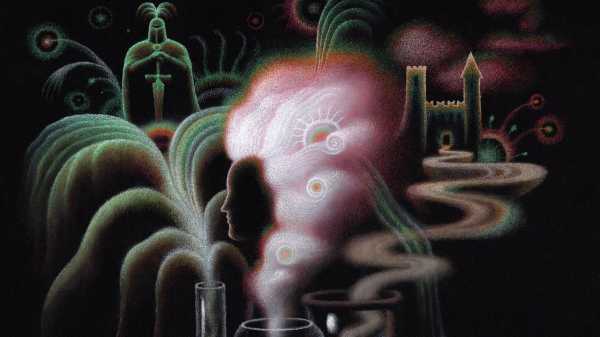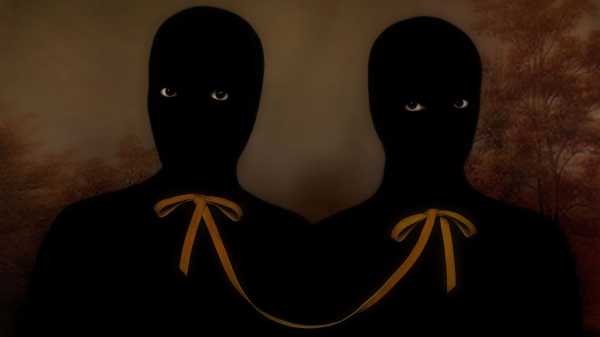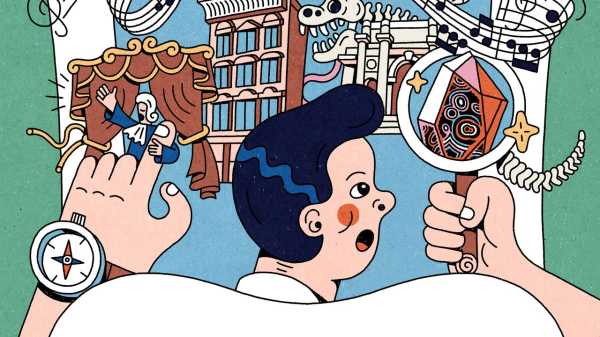
Save this storySave this storySave this storySave this story
This past August, in a windowless room of the British Library, in London, Tasha Marks was enacting her own form of time travel. Marks is a scent designer who works with museums, heritage sites, and other cultural spaces to create odors that can open an instant portal to the past. The library had commissioned her to concoct historical smells for an exhibition about the lives of medieval women. On a conference table, Marks placed an array of bottles and fanned out several mouillettes—the paper strips that perfumers use to sample fragrances.
The library would be putting on display a thirteenth-century edition of a remarkable Latin manuscript called “De Ornatu Mulierum,” a compendium of beauty and hygiene advice for women. Marks had obtained ingredients listed in the manuscript to re-create the smell of a breath freshener and of a hair perfume that would have been applied as a powder, like dry shampoo. (“Let her make furrows in her hair and sprinkle on the aforementioned powder, and it will smell marvellously.”) The text didn’t offer exact recipes—no proportions were provided—so there was an element of improvisation, allowing Marks to act as both historian and artist.
Eleanor Jackson, the show’s lead curator, and Freya Barry, a publicist at the library, were eager to smell Marks’s latest drafts. Jackson hoped that the exhibition would counter the misconception that medieval women were universally downtrodden drudges. The library’s galleries would be telling the stories of some formidable women, including Gwerful Mechain, a Welshwoman who, in the fifteenth century, wrote a delightfully lewd “Ode to the Vagina.” (“I declare, the quim is fair / circle of broad-edged lips / it is a valley longer than a spoon or a hand, / a ditch to hold a penis two hands long.”) The show also aimed to correct the notion that medieval people were hostile to hygiene. In fact, Marks told me, medieval Europeans of all social classes washed their hands and faces and genitals “almost every day,” though hot water wasn’t easy to come by and full immersion was regarded as dangerous. They also scrubbed their clothes—though they sometimes used urine to do so. (The ammonia in it helped remove stains.)
The breath-freshener smell that Marks had devised was a combination of laurel leaves—peculiar to the modern sensibility, but not off-putting—and musk. Synthetic musk is still used in perfumes, but in the medieval era the ingredient would have been obtained from a gland nestled close to a deer’s penis, and it would have been very strong. As Marks put it, “Yeah, today, we don’t tend to want animalistic breath.” More appetizingly, laurel leaves often tingle in the mouth, in the manner of eucalyptus or spearmint. The Latin manuscript helpfully suggested that a woman anticipating sexual intercourse might place the concoction under her tongue.
The hair perfume, too, had a musk note, but also hints of rose, clove, and nutmeg, and, more unusually, watercress and galangal, a ginger-like root. The result was, as Marks said, “heady, spicy, and rich,” but lifted by the bright green of the watercress. I’d recently been on a perfume jag, wreathing myself in enticing scents from au-courant brands, but I liked this fragrance more than any of them. It smelled like Christmas dusted with the promise of spring. Marks said that the hair perfume had come together quickly by her standards—in one or two drafts.
The show, “Medieval Women: In Their Own Words,” would also feature some scents that were imaginative leaps. One of these would evoke a vivid mystical vision of the religious figure Julian of Norwich in which she was nearly smothered by the Devil in a vile “stinke.” Marks told the library staff that she’d made a concoction, foregrounding artificial approximations of scorched excrement, that was “smoky and fetid and bodily” but “not sick-making.” Marks, who is thirty-seven and crops her hair like a member of a nineties boy band, is cheerfully forthright. “We don’t want people running out of the exhibition,” she said. (No visitors would be forced to smell anything; to partake, they could lower their noses into “scent chambers” placed among the displays.)
For the breath freshener and the hair perfume, Marks collaborated with Angela Stavrevska, a perfumer at CPL Aromas, a company that makes fragrances and household products. For the “stinke,” Marks worked with Liam Findlay, of AromaPrime, which is more oriented toward entertainments, such as immersive rides and escape rooms. CPL’s working materials include the standard ingredients of modern fragrance design, from bergamot to sandalwood. AromaPrime’s catalogue of more than four hundred odors includes “badger poo,” “blood,” and “dungeon mildew.”
Marks’s company, a one-woman outfit called AVM Curiosities (for “animal, vegetable, mineral”), specializes in the past. In 2021, for an exhibition at the London Museum Docklands, she designed odors that evoked the London docks at various points in the city’s industrial history, from the eighteen-nineties (concrete warehouses full of animal hides) to the nineteen-eighties (the oily-engine smells of boats plying the Thames). For an exhibition in Northern Ireland, she conjured the sensory shocks awaiting women who emigrated from rural Ireland to New York City (a tenement house, Coney Island on a summer’s day). At Rochester Castle, a striking Norman ruin near London, she’d evoked the acrid funk of a medieval cesspit and the spicy scent of burning incense, based on a recipe from 1088. For Chatsworth House, a stately pile in the Derbyshire countryside, Marks replicated the odors of dinners that had been served there in the mid-nineteenth century: visitors to the historic house, which is open to the public, could lift the lids of silver tureens and inhale ghostly emanations of pineapple jelly and mutton with truffle sauce.
This summer, Marks is working on four scents to be featured in the exhibit “Marie Antoinette Style,” which will open in September at the Victoria & Albert Museum, in London. Marks told me that, handily, there were actual receipts of the doomed French queen’s self-care purchases, “what makeup she wore and the perfumes she favored—heavily floral and powdery, with orris root and rose.” Marks was also able to confidently drum up a smell approximating that of Marie Antoinette’s garden at the Petit Trianon, because historians know which flowers were planted there. More interpretive would be Marks’s distillation of a masquerade ball at Versailles (“oak parquet floors, beeswax candles, a smidge of floral and smoke, that sort of welcoming smell of a party—bodies, but in a pleasant way”).
Marks’s research is meticulous. For the Docklands show, she pinpointed specific smell memories by consulting oral histories that the museum had collected from people who had lived and worked around the docks; at Chatsworth House, she combed through its extensive archive of menus. Re-creating historical smells was fun, she said, but it also had a deeper purpose—to reanimate “intangible histories that are really important to people but tend to change or disappear over time.”
Some scholars find efforts to mimic historical smells a little too consumer-driven and theme-parky. Mark M. Smith, a professor of history at the University of South Carolina, is the author of “A Sensory History Manifesto,” in which he notes that “curatorial tricks” aiming to re-create historical sensations can be misleading. Although it might be “theoretically possible to re-create,” say, the smell of a medieval dungeon or a nineteenth-century tenement house, Smith told me, in an e-mail, “it is impossible to consume, to experience those sensations the same way” that people did at the time. Something that smells putrid to us now, for instance, might not have assaulted medieval noses in the same way.
But Marks argues that smell is one of the most potent ways to give museum visitors a visceral sense of the past, and to help them remember what they read or saw in an exhibit. Among the scents she designed for the docks exhibition was one inspired by a woman’s memory, in the oral histories, of her dockworker father’s damp woollen coat drying on an electric fire in the nineteen-sixties. Marks thought that the coat might have smelled like her own grandfather’s wool flat cap. He’d been a London cabdriver, and she’d loved it when he would pick her up from school in his black taxi and bring her along to hang out with his fellow-drivers. She’d kept his cap after he died. When Marks shared the odor she’d devised with some local families who’d lived near the docks, one woman found it so familiar and nostalgic that she cried and started excitedly describing the wallpaper in the house she’d grown up in. Marks told me, “If you get a smell and it sparks off a memory like that, you know you’ve got it right.”
There are physiological reasons why smell can trigger memories more effectively than other senses. The olfactory cortex is closely connected to the amygdala, a part of the brain that processes emotions, and to the hippocampus, a key region for memory. Rachel Herz, a neuroscientist at Brown University who studies smell, told me that it is the only sensory system in which a sensation is produced and consciously experienced in the same regions of the brain where emotions and memories are made. “This uniquely direct neuroanatomical link,” Herz has written, helps explain why “odor-evoked memories” can be so emotionally potent. The flood of memories unleashed by Proust’s madeleine was as much a function of smell as of taste. Marks noted to me that, when we recall things we’ve seen or heard, we are always remembering the most recent time we remembered it, as well, and so the initial impression “dilutes over time—whereas with smell and taste it’s the same primal stimulus again.” Sniffing something that you haven’t encountered in twenty or thirty years—Play-Doh, fresh-cut hay, your grandmother’s laundry detergent—can be as vivid a sensory experience as it was the first time, while also being almost psychedelically nostalgic.
The experience of scent as a whooshing rocket to the past is more recognizable to some of us than to others. Herz explained that, from youth to old age, “females on average have a higher acuity for being able to detect odorants.” That acuity is heightened during ovulation and diminished during the menstrual phase. Herz noted, “There is a lot of information that can be gained from smell about the health and genetic compatibility of potential mates.”
But this can’t be the only reason for this female advantage, since it also holds true pre-puberty and post-menopause. In general, it’s probably been more important socially for women to smell good, and so being good at smelling is a skill they have had more incentive to refine. As Herz pointed out, though, this gender difference manifests only on average; there is “huge individual variation” in sensitivity—and partiality—to specific fragrances. There are male perfumers with exquisitely refined noses and women who can’t tell Irish Spring from an Irish spring.
Smell just matters more to some of us than to others. Certain writers make a feast of odors. Dickens’s novels brim with descriptions of smells, a tendency that reflects what the critic John Mullan calls the author’s “sheer sensory inclusiveness,” but also, perhaps, a particularly olfactory bent. Dickens’s former office boy remembered him as a “man who lived a lot by his nose,” adding, “He seemed to be always smelling things. When we walked down by the Thames he would sniff and sniff.” By contrast, I can hardly remember one olfactory moment in Austen’s novels.
Andy Warhol once observed, “Seeing, hearing, touching, tasting are just not as powerful as smelling, if you want your whole being to go back for a second to something.” He compiled a lengthy digest of scents that he noticed while walking around New York, including “the good cheap candy smell in the front of Woolworth’s” and the “exhausts from apartment house laundry rooms." Warhol felt a special nostalgia for the way the lobby of one movie theatre, the Paramount, in Times Square, used to smell: “I would close my eyes and breathe deep whenever I was in it. Then they tore it down. I can look all I want at a picture of that lobby, but so what? I can’t ever smell it again.”
Tasha Marks’s work attracted my attention because, for as long as I can remember, I’ve been obsessed with scent—not so much perfume as the everyday smells of the places I’ve lived and the people I’ve loved. As a college student at U.C. Berkeley, I’d sometimes feel homesick for long days of bodysurfing and tidepool-exploring on Southern California beaches with my family; I’d go to the Walgreens on Telegraph Avenue and open a bottle of Sea & Ski—our household’s sunblock of choice—and huff it right there in the aisle. I’ve been known to take an absent loved one’s unlaundered clothing to bed with me—my sister’s when I was a little kid and she went off to college; my husband’s when he was reporting from Sarajevo during the Balkans conflict and I both missed him and worried about him. A few months ago, I came across a letter I’d written to my sister when I was ten and she was eighteen, attesting to my weirdly ardent olfactory habit: “I take your dress to bed every night but it’s loosing it’s sniff. I’m disparate.” Sleeping with such items felt feral, doglike, and immensely comforting.
If I try hard enough, I can summon long-disappeared smells from my past: the damp, slightly sweet smell of mimeographed sheets from elementary school; the chemical orange of St. Joseph baby aspirin. For me, no scent will ever capture the promise of freedom and transgression and youthful reinvention quite like the sweet rot of New York City garbage on a summer night in, say, the East Village. I first encountered that intoxicating smell on a visit in the early eighties, when I was a suburban California teen-ager enamored of New Wave, old movies, and East Coast grit.
In recent years, many museums and other cultural institutions have been experimenting with a nose-forward approach. From 2015 to 2020, Caro Verbeek, an art historian, offered a tour of the Rijksmuseum during which visitors were invited to experience odors suggested by a number of works, including a giant historical painting depicting the Battle of Waterloo. (Among the olfactory elements that were blended to accompany the image: the smells of horses, gunpowder, burnt and moist earth, and “anxiety sweat.”) A 2022 exhibition at the Museo del Prado, in Madrid, offered visitors more traditional aromatic accompaniments—roses, orange blossom, jasmine—for an exhibition of early modern Flemish and northern European paintings, many of which included images of flowers.
A recent Broadway revival of Thornton Wilder’s “Our Town” had a minimalist set, but, at key moments, scents were dispersed into the theatre to establish a nostalgic mood—heliotrope, vanilla ice cream, frying bacon. For the Metropolitan Museum of Art’s Costume Institute show in 2024, a smell artist named Sissel Tolaas analyzed molecules extracted from the clothes and accessories on display in order to re-create how they had smelled on their original wearers. A reporter who visited the show for NPR said, “What I am smelling is the scent of a woman’s skin taken from the dress she wore around the turn of the last century. This is a completely different way of experiencing an object at a museum. Smell makes the women who wore these dresses feel present.”
Curators who have been incorporating smell into their exhibitions told me that it can make the experience more richly emotional. It also seems to make visitors less shy amid the intimidating “white cubes” of museums and galleries. The curator Claire Dobbin, who worked with Marks on the Docklands exhibition, told me, “As soon as you start smelling things, people have associations and experiences and they start to share them.” She continued, “They start talking to one another,” sharing memories—often “quite personal” ones. “And they don’t worry about getting it wrong! Whereas, with art and museums, a lot of people feel like, Oh, I can’t say anything, they’re the experts.”
Sometimes, the effect of introducing a smell into an exhibition is as unintentional as it is powerful. In 2022, curators at a museum in Ulm, Germany, began offering scents for patrons to savor while gazing at various paintings in their collection. An abstract Ellsworth Kelly canvas called “Orange Blue” was paired with a citrus-and-marine smell that for some visitors evoked the men’s cologne Cool Water, by Davidoff. One day, a group of women from Ukraine, where the cologne is a familiar scent, visited the museum. Russia had recently invaded their country, displacing the women. Some were reminded of their fathers, brothers, and sons back home, and began to cry.
Marks was born and raised in London, the daughter of an accountant father and a stay-at-home mother. At the University of Sussex, in Brighton, she got an art-history degree, but, she told me, “I realized I was passionate about art but also about food and the senses.” She began doing research in food history and wrote her undergraduate thesis on jellies—the fantastical molded desserts that have dazzled guests at fancy English meals since medieval times. “I was fascinated that jellies were once seen as massive status symbols,” she told me. “They used to cost as much as a portrait!” At college, she also put on playful, immersive burlesque-and-cabaret nights, in pubs and other venues around raffish Brighton; at one, she released balloons infused with flavor drops that smelled like cake. As an undergraduate, she also met her future wife, Fiona Russell, who is now a publicist for museums and galleries.
After graduation, Marks returned to London and took jobs in publishing, at a bakery, and at a company, Bompas & Parr, that did whimsical food design for events. “I got into the showmanship,” Marks recalled. “They made things like a cocktail lake you could float across”—based on a vast punch bowl at a real party hosted by a British admiral in 1694. (At that event, a boy in a rowboat stirred a boozy punch with his oars.)
She began researching the wonderments of various historic festivities, and came across “stories of people having trees planted around the banqueting area so the scent of the trees would waft through, or putting rosewater on doves and letting them go during the dessert course, so that the perfume filled the air.” She sensed a career opportunity: “I felt that, with modern museums, what we had gained in knowledge we had lost in spectacle, and they had become quite sterile. And, actually, flavor and fragrance were great ways to add that back in.”
At the time, immersive events and after-hours programming were becoming popular at museums, and Marks rode the wave. In 2015, at the National Gallery in London, she put together a tasting menu of Spanish turrones—a traditional form of flavored nougat—which was served in a room of paintings by Zurbarán and Velázquez. On her own, she curated an exhibit at the Herrick Gallery, in Shoreditch, about ambergris, a substance that had long fascinated her, because it occupies such an uncategorizable niche. It’s sometimes described as whale vomit, but it’s more like a bezoar or a gallstone, and is made up primarily of the indigestible beaks of the squid that whales eat. This agglomeration of leftovers is eventually disgorged by the animal (or found after its death, if the whale is cut open). Ambergris has been used in perfumes for centuries. Marks told me, “If you let it mature in the sea, like an oceanic truffle, it starts to turn white, and often washes up on beaches—that’s the really good stuff, very expensive.” She wrote to perfumers, looking for an odiferous sample to display, and eventually found her way to Angela Stavrevska, the perfumer at CPL, who loaned her a small chunk of ambergris that the company kept on hand as a curiosity. Scent began to interest Marks more, and she enrolled in perfumery courses, at the London College of Fashion and elsewhere. She discovered that she had a knack for imagining smells in her mind. Marks told me, “When I’m thinking about how to balance a formula, I’m moving it around in my head the same way that someone, when reading or writing music, might hear the notes in their head.”
Marks and Russell live in a cute house in Walthamstow, in east London, with their infant son and their dog, a corgi. Upstairs is Marks’s studio, where the shelves are full of food and scent-history books, along with vintage cookbooks (“Mrs. Beeton’s Cold Sweets, Jellies, Creams, Fruit Dishes, Cold Puddings, and Ices,” “The Alice B. Toklas Cook Book”). On Marks’s desk, a row of small scent cannisters stood ready to be mixed.
Russell told me that she often acts as Marks’s “Joe Nose”—an in-house adviser with an average sense of smell. “When she’s working on something, she gets so excited,” Russell noted. “And she’ll be, like, ‘I’ve done it!’ and she runs downstairs and puts a smell tab under my nose, and she’ll be, like, ‘What do you think? What does it say?’ And sometimes I need a little bit more context. If it’s the smell of marzipan, I’m, like, ‘Sure, that’s marzipan, lovely.’ But if it’s something like the smell of a dockworker who’s just arrived home after a long day at the shipyard, hung up his coat, put his shoes to the side, and begun having a cup of tea with his wife, I’m, like, ‘I don’t know!’ But I love the depth of the storytelling that has gone into it—sometimes days or hours of work have gone into compiling the scent. And then when she’s arrived at it, she’s, like, ‘That’s it!’ ”
One afternoon in London, Marks introduced me to two friends of hers, Will Tullett, a historian of smell, and Cecilia Bembibre, a research scientist whose work involves analyzing and preserving “heritage smells.” We met for coffee at a bookstore café in Bloomsbury (where, with my sniffer more primed than usual, I appreciated how the espresso-machine steam had blended the aroma of warm scones, coffee beans, and printed matter). Tullett, who teaches at the University of York, has written two books about smell and history. The topic first became a scholarly one in the nineteen-eighties, when the French historian Alain Corbin published his lively and influential “The Foul and the Fragrant: Odor and the French Social Imagination.” Corbin chronicled how, starting in the late eighteenth century, “bourgeois control of the sense of smell” created a sense of horror about odors that had previously generated little alarm. (In 1773, Corbin noted, “Powder was exploded inside the church of Saint-Étienne at Dijon to drive out the stench of corpses.”) Tullett’s work, however, often pushes back against what he calls “the deodorization narrative”—the idea that the modern world uniformly smells much better today. I was initially skeptical: what about the fetid sludge of raw sewage in the streets of Paris or London? Tullett explained that such unpleasant smells haven’t gone away; they’ve just been redistributed. In some rural areas, for example, there is “hog farming on an industrial scale, with mass amounts of waste that smells wretched.”
Bembibre is a research director at the University College London’s Institute for Sustainable Heritage, where she works on identifying and preserving “intangible heritage”—scents in particular. Whereas Marks typically reconstructs smells by consulting recipes, diaries, or other historical texts, Bembibre employs chemical means. After taking an air sample from a physical environment or from an object placed in a sealed container, she analyzes the volatile organic compounds contained in the sample with gas chromatography and mass spectrometry, also known as G.C.-M.S. (The technique was originally used in forensic and conservation contexts, to reveal traces of chemicals on the brink of disintegration.) A G.C.-M.S. analysis yields a list of compounds and their proportions, allowing an almost vanished scent to be documented and reconstructed. Bembibre has employed the method to capture the smell of the library at St. Paul’s Cathedral (the odor of old books turns out to contain a compound, furfural, that reminds people of bread and almonds) and to analyze the chemical components of potpourri from a 1750 recipe favored by the Sackville-West family, and lovingly described by Vita Sackville-West’s lover Virginia Woolf in “Orlando.” The potpourri was a heady concoction of rose leaves, violets, myrtle flowers, rosemary, and other dried ingredients—or, as Bembibre found, hexanol and other chemicals.
After we finished our coffees, we walked over to Bembibre’s lab at U.C.L., where she showed me the equipment that she uses for scent analysis, and offered various foul and fragrant smells for all of us to sample. “Want to try butyric acid?” she asked, as though offering a cup of tea. I took a whiff. To me, it smelled like sweaty feet. To some people, it smells like vomit. “You know what’s funny?” Bembibre said. “It’s found in Hershey’s chocolate,” as a natural (and harmless) byproduct of decomposing milk. Bembibre, who grew up in Argentina, said, “You probably grew up with that chocolate. I tried it as an adult for the first time, and I hated it.”
“Smell, it’s quite a cultural thing, isn’t it?” Tullett said. “A classic example is wintergreen, which in the U.S. is in root beer. In the U.K., it was in lots of medicines. So people in the U.K. have quite a negative association with wintergreen.”
The conversation turned to a new project of Bembibre’s: a study of a sample of Russian leather, a material once prized by bookbinders and fine-furniture makers, particularly in eighteenth-century Europe. She brought out a crinkly nalophan bag with a sheet of russet-brown leather inside, which she drew out with nitrile-gloved hands. The sample came from a leather-conservation center in Northampton. In 1973, divers explored the wreck of the Metta Catharina, a ship carrying an enormous store of Russian leather which had sunk in the English Channel in 1786. “The leather was tightly wrapped in rolls,” Bembibre said. “When they rescued it, the rolls in the middle were still so good that they could be used to make Hermès bags.” We all smelled the leather. It was seductively smoky, with an undercurrent of the birch oil that had been used to tan it. Because she regarded the scent as historically significant, she wanted to generate a chemical analysis, a recipe of sorts, that would allow future generations to re-create it.
Bembibre learned about the shipwreck in 2023, via a blog post, and she became determined to get ahold of a sample of the leather. In her work, she sometimes encounters people who theorize about or describe smells without trying, first, to smell them—this astonishes her. “I’ve read whole articles in which people discuss an historic perfume without having checked to see that someone has reworked that perfume and you can have the actual experience of it. For me, this is incredible! I would not think of doing it that way. If I read about it, I want to smell it.” Marks nodded emphatically.
After “Medieval Women” opened at the British Library, last October, I got in touch with Jackson, the curator, to see how Marks’s smells had gone over. She declared them “a hit,” adding, “People are queuing to smell them.” Jackson had seen numerous visitors beckoning their friends over to get a whiff of the “stinke” evoking Hell.
The Library had held a panel discussion one evening about medieval beauty regimens. At the event, mouillettes bearing Marks’s hair-perfume and breath-freshener scents were passed around. Jackson had been delighted by the number of young people who had turned out, a perennial goal for august cultural institutions. She said of Marks, “She’s so enthusiastic that it’s very contagious.”
Indeed, Marks recently inspired me to conduct my own scent experiment. My mother’s favorite perfume, Bellodgia, by Caron, had not been manufactured in years. She died in 1989, when I was twenty-seven and she was sixty, just a little younger than I am now. We’d been very close, and she had been a Technicolor personality, fiercely loving and exuberant, a former torch singer who was always belting jazz standards around the house. Images of her came to me often, as did snatches of songs in her repertoire, which she sang to me as lullabies. (“I wish you bluebirds in the spring / to give your heart a song to sing”). What I couldn’t quite summon, despite what I thought of as my keen smell memory, was her fragrance.
As a kid, I had never liked it. Bellodgia was heavy, spicy, and floral; when my mother would lean over me to comb my hair, which was perpetually tangled, the cloying rose and carnation combined with her tugging on my scalp always threatened to give me a headache. Still, just as I missed her uncanny ability to read my mood from the word “Hello”—something that had both comforted and exasperated me when I was a teen-ager—I missed that fragrance now.
Online, I found that there were sites that sold discontinued perfumes, and I found a Bellodgia sample being offered by a seller on eBay. I came across websites for perfume aficionados on which people praised the formulation’s luxurious complexity, especially the carnation note, which, as one commenter wrote, seemed to say, “Alright, Mr. DeMille, I’m ready for my closeup.” No wonder my mom had loved it. Researching further, I learned that Bellodgia had been developed in 1927, the year before my mother was born, by a Parisian perfumer of Russian Jewish origin, Ernest Daltroff. His calling had apparently been inspired by his own mother’s habit of dabbing fragrance behind his ears every night before he went to sleep.
The package arrived. Inside was a vial of Bellodgia. When I smelled it, I was sure it was the real thing, hardly faded, not a re-creation. The rich, overpowering rose and carnation were still there. And so, for a moment, was my mother. ♦
Sourse: newyorker.com







